Statistical Analysis Assignment 2: Data Interpretation and Analysis
VerifiedAdded on 2021/06/17
|15
|1409
|164
Homework Assignment
AI Summary
This assignment presents a comprehensive statistical analysis covering various topics. The first question involves analyzing quarterly opening stock prices for MQG and PPT, using stem-and-leaf plots, histograms, and frequency polygons to compare investment potential. The second question calculates and interprets mean, median, quartiles, standard deviation, and range for different variables, along with box and whisker plots, to assess growth potential. Question three delves into the probabilities of Australian deaths from neoplasms and circulatory diseases. Question four focuses on calculating rainfall probabilities, assuming a normal distribution. Finally, question five examines the normality of refractive index data for float and non-float glass, including confidence intervals for normally distributed variables. The assignment demonstrates the application of various statistical techniques to real-world scenarios, drawing conclusions based on the data analysis.

Running head: ASSIGNMENT 2
Assignment 2
Name
Course Number
Date
Faculty Name
Assignment 2
Name
Course Number
Date
Faculty Name
Paraphrase This Document
Need a fresh take? Get an instant paraphrase of this document with our AI Paraphraser
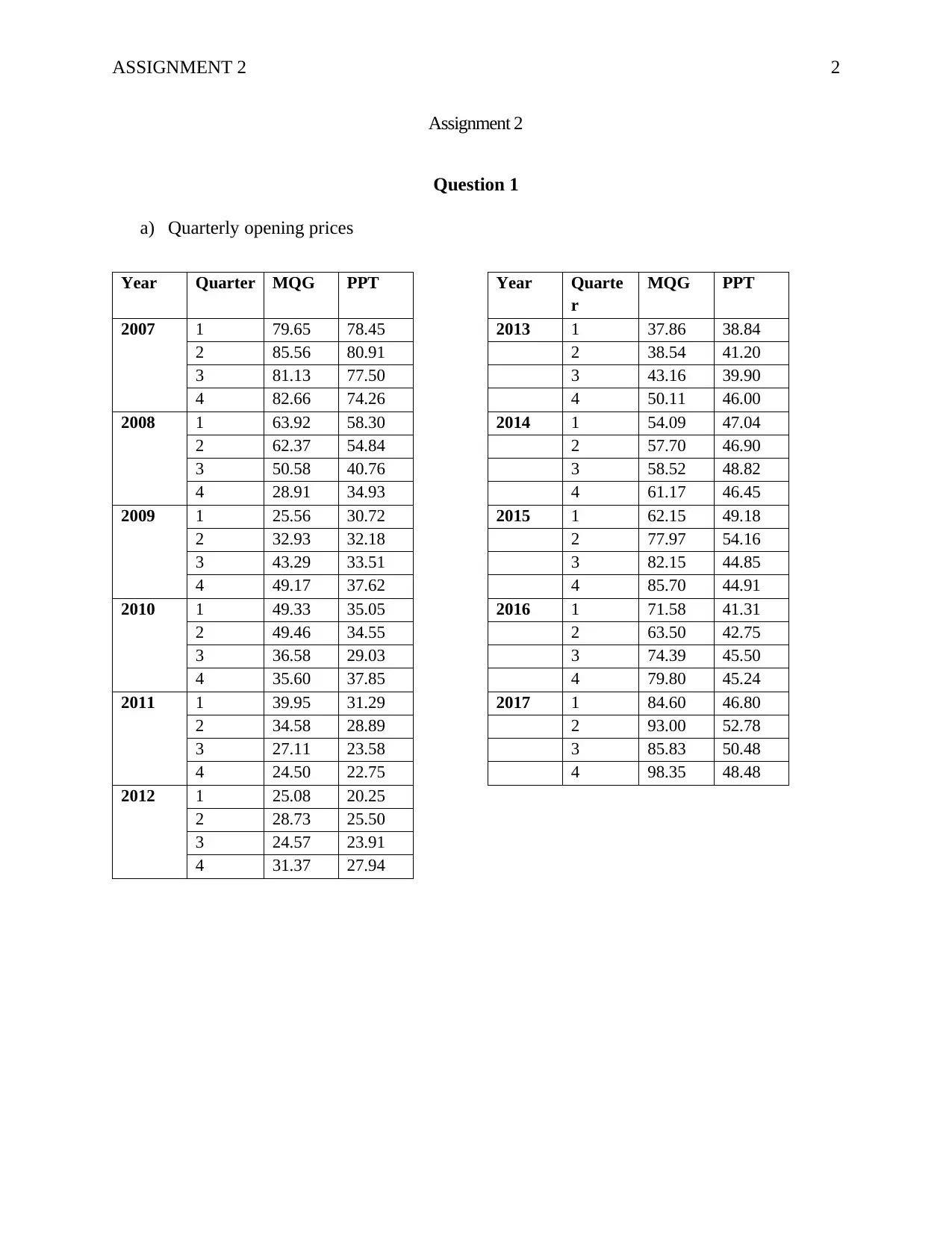
ASSIGNMENT 2 2
Assignment 2
Question 1
a) Quarterly opening prices
Year Quarter MQG PPT Year Quarte
r
MQG PPT
2007 1 79.65 78.45 2013 1 37.86 38.84
2 85.56 80.91 2 38.54 41.20
3 81.13 77.50 3 43.16 39.90
4 82.66 74.26 4 50.11 46.00
2008 1 63.92 58.30 2014 1 54.09 47.04
2 62.37 54.84 2 57.70 46.90
3 50.58 40.76 3 58.52 48.82
4 28.91 34.93 4 61.17 46.45
2009 1 25.56 30.72 2015 1 62.15 49.18
2 32.93 32.18 2 77.97 54.16
3 43.29 33.51 3 82.15 44.85
4 49.17 37.62 4 85.70 44.91
2010 1 49.33 35.05 2016 1 71.58 41.31
2 49.46 34.55 2 63.50 42.75
3 36.58 29.03 3 74.39 45.50
4 35.60 37.85 4 79.80 45.24
2011 1 39.95 31.29 2017 1 84.60 46.80
2 34.58 28.89 2 93.00 52.78
3 27.11 23.58 3 85.83 50.48
4 24.50 22.75 4 98.35 48.48
2012 1 25.08 20.25
2 28.73 25.50
3 24.57 23.91
4 31.37 27.94
Assignment 2
Question 1
a) Quarterly opening prices
Year Quarter MQG PPT Year Quarte
r
MQG PPT
2007 1 79.65 78.45 2013 1 37.86 38.84
2 85.56 80.91 2 38.54 41.20
3 81.13 77.50 3 43.16 39.90
4 82.66 74.26 4 50.11 46.00
2008 1 63.92 58.30 2014 1 54.09 47.04
2 62.37 54.84 2 57.70 46.90
3 50.58 40.76 3 58.52 48.82
4 28.91 34.93 4 61.17 46.45
2009 1 25.56 30.72 2015 1 62.15 49.18
2 32.93 32.18 2 77.97 54.16
3 43.29 33.51 3 82.15 44.85
4 49.17 37.62 4 85.70 44.91
2010 1 49.33 35.05 2016 1 71.58 41.31
2 49.46 34.55 2 63.50 42.75
3 36.58 29.03 3 74.39 45.50
4 35.60 37.85 4 79.80 45.24
2011 1 39.95 31.29 2017 1 84.60 46.80
2 34.58 28.89 2 93.00 52.78
3 27.11 23.58 3 85.83 50.48
4 24.50 22.75 4 98.35 48.48
2012 1 25.08 20.25
2 28.73 25.50
3 24.57 23.91
4 31.37 27.94
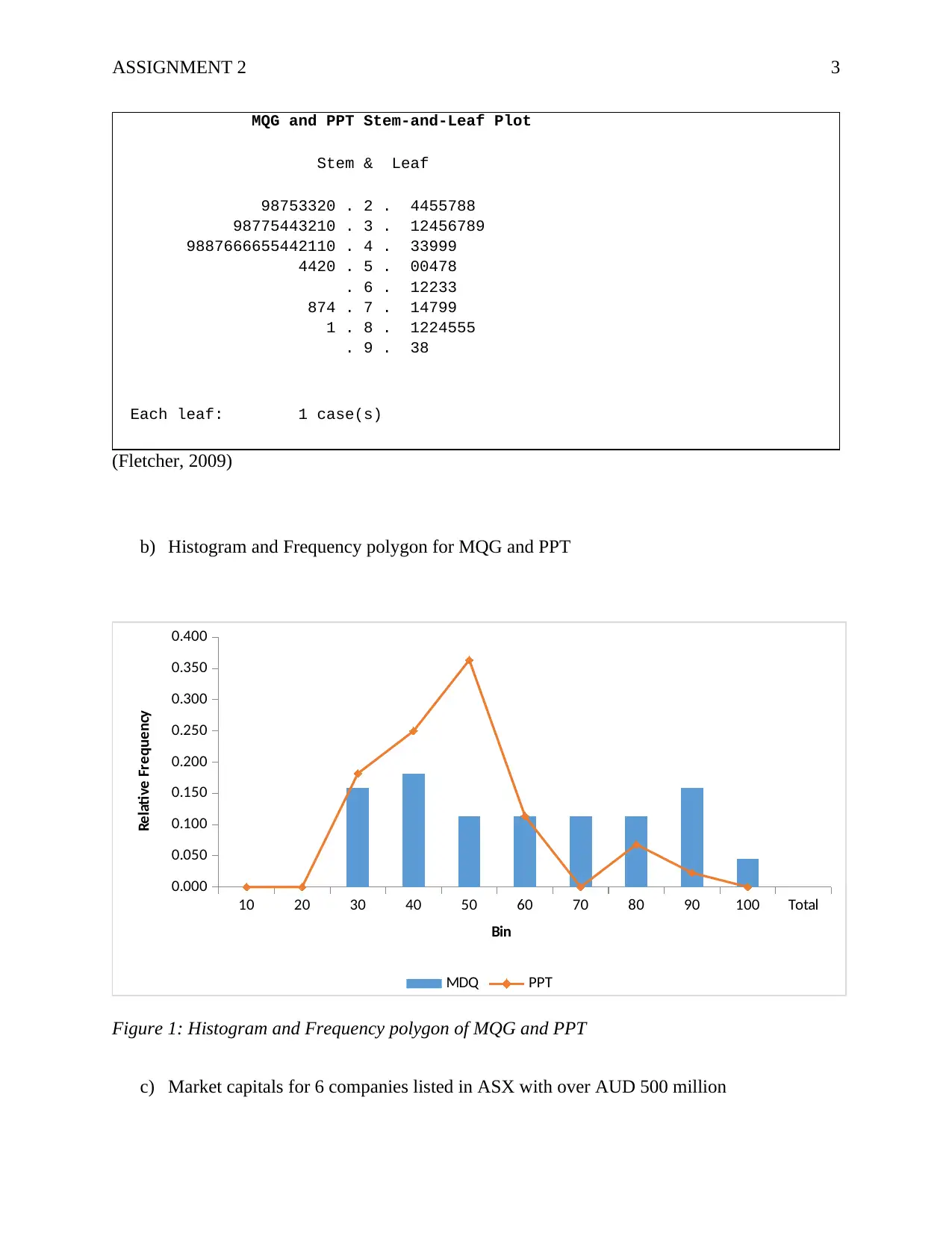
ASSIGNMENT 2 3
MQG and PPT Stem-and-Leaf Plot
Stem & Leaf
98753320 . 2 . 4455788
98775443210 . 3 . 12456789
9887666655442110 . 4 . 33999
4420 . 5 . 00478
. 6 . 12233
874 . 7 . 14799
1 . 8 . 1224555
. 9 . 38
Each leaf: 1 case(s)
(Fletcher, 2009)
b) Histogram and Frequency polygon for MQG and PPT
10 20 30 40 50 60 70 80 90 100 Total
0.000
0.050
0.100
0.150
0.200
0.250
0.300
0.350
0.400
MDQ PPT
Bin
Relative Frequency
Figure 1: Histogram and Frequency polygon of MQG and PPT
c) Market capitals for 6 companies listed in ASX with over AUD 500 million
MQG and PPT Stem-and-Leaf Plot
Stem & Leaf
98753320 . 2 . 4455788
98775443210 . 3 . 12456789
9887666655442110 . 4 . 33999
4420 . 5 . 00478
. 6 . 12233
874 . 7 . 14799
1 . 8 . 1224555
. 9 . 38
Each leaf: 1 case(s)
(Fletcher, 2009)
b) Histogram and Frequency polygon for MQG and PPT
10 20 30 40 50 60 70 80 90 100 Total
0.000
0.050
0.100
0.150
0.200
0.250
0.300
0.350
0.400
MDQ PPT
Bin
Relative Frequency
Figure 1: Histogram and Frequency polygon of MQG and PPT
c) Market capitals for 6 companies listed in ASX with over AUD 500 million
⊘ This is a preview!⊘
Do you want full access?
Subscribe today to unlock all pages.

Trusted by 1+ million students worldwide
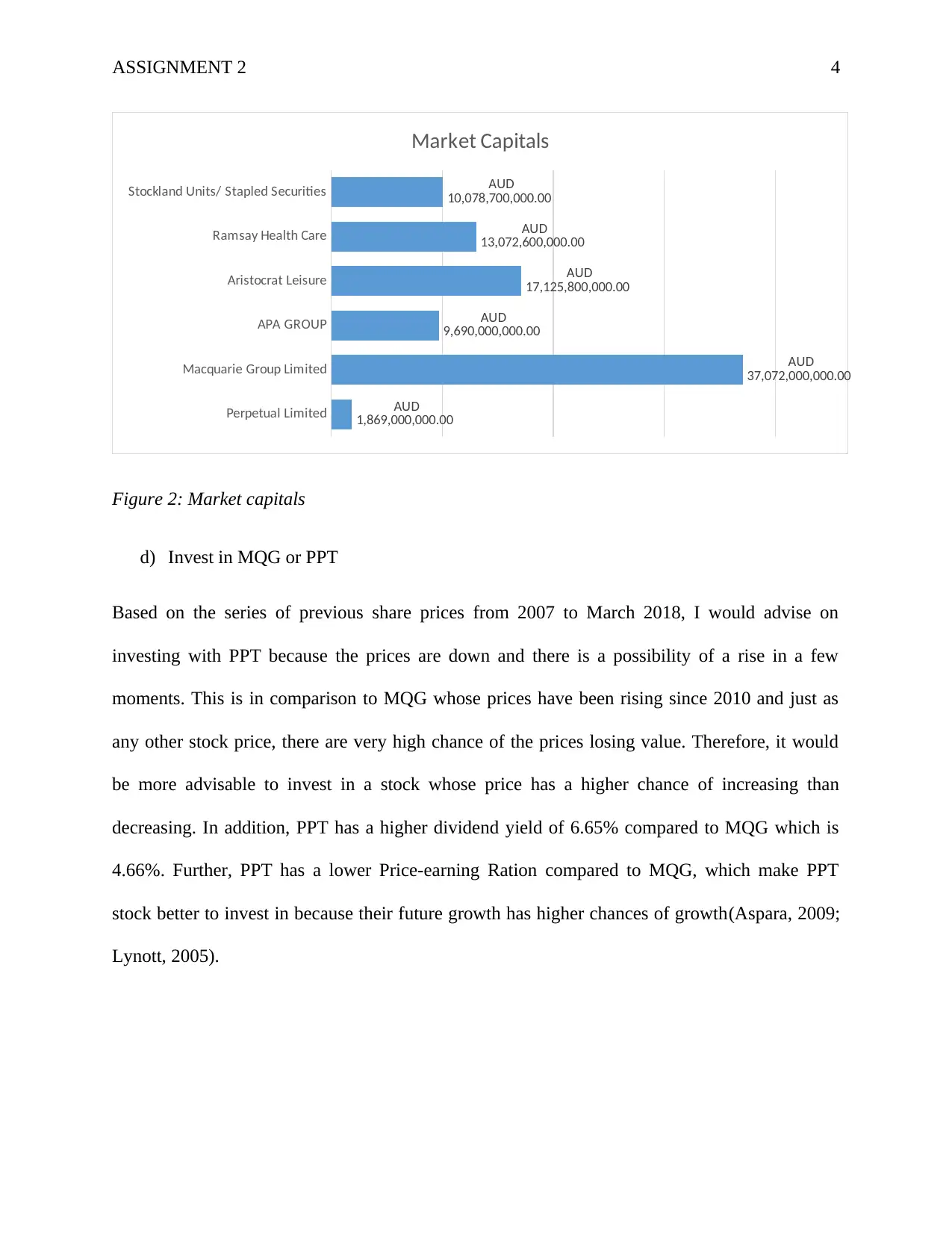
ASSIGNMENT 2 4
Perpetual Limited
Macquarie Group Limited
APA GROUP
Aristocrat Leisure
Ramsay Health Care
Stockland Units/ Stapled Securities
AUD
1,869,000,000.00
AUD
37,072,000,000.00
AUD
9,690,000,000.00
AUD
17,125,800,000.00
AUD
13,072,600,000.00
AUD
10,078,700,000.00
Market Capitals
Figure 2: Market capitals
d) Invest in MQG or PPT
Based on the series of previous share prices from 2007 to March 2018, I would advise on
investing with PPT because the prices are down and there is a possibility of a rise in a few
moments. This is in comparison to MQG whose prices have been rising since 2010 and just as
any other stock price, there are very high chance of the prices losing value. Therefore, it would
be more advisable to invest in a stock whose price has a higher chance of increasing than
decreasing. In addition, PPT has a higher dividend yield of 6.65% compared to MQG which is
4.66%. Further, PPT has a lower Price-earning Ration compared to MQG, which make PPT
stock better to invest in because their future growth has higher chances of growth(Aspara, 2009;
Lynott, 2005).
Perpetual Limited
Macquarie Group Limited
APA GROUP
Aristocrat Leisure
Ramsay Health Care
Stockland Units/ Stapled Securities
AUD
1,869,000,000.00
AUD
37,072,000,000.00
AUD
9,690,000,000.00
AUD
17,125,800,000.00
AUD
13,072,600,000.00
AUD
10,078,700,000.00
Market Capitals
Figure 2: Market capitals
d) Invest in MQG or PPT
Based on the series of previous share prices from 2007 to March 2018, I would advise on
investing with PPT because the prices are down and there is a possibility of a rise in a few
moments. This is in comparison to MQG whose prices have been rising since 2010 and just as
any other stock price, there are very high chance of the prices losing value. Therefore, it would
be more advisable to invest in a stock whose price has a higher chance of increasing than
decreasing. In addition, PPT has a higher dividend yield of 6.65% compared to MQG which is
4.66%. Further, PPT has a lower Price-earning Ration compared to MQG, which make PPT
stock better to invest in because their future growth has higher chances of growth(Aspara, 2009;
Lynott, 2005).
Paraphrase This Document
Need a fresh take? Get an instant paraphrase of this document with our AI Paraphraser
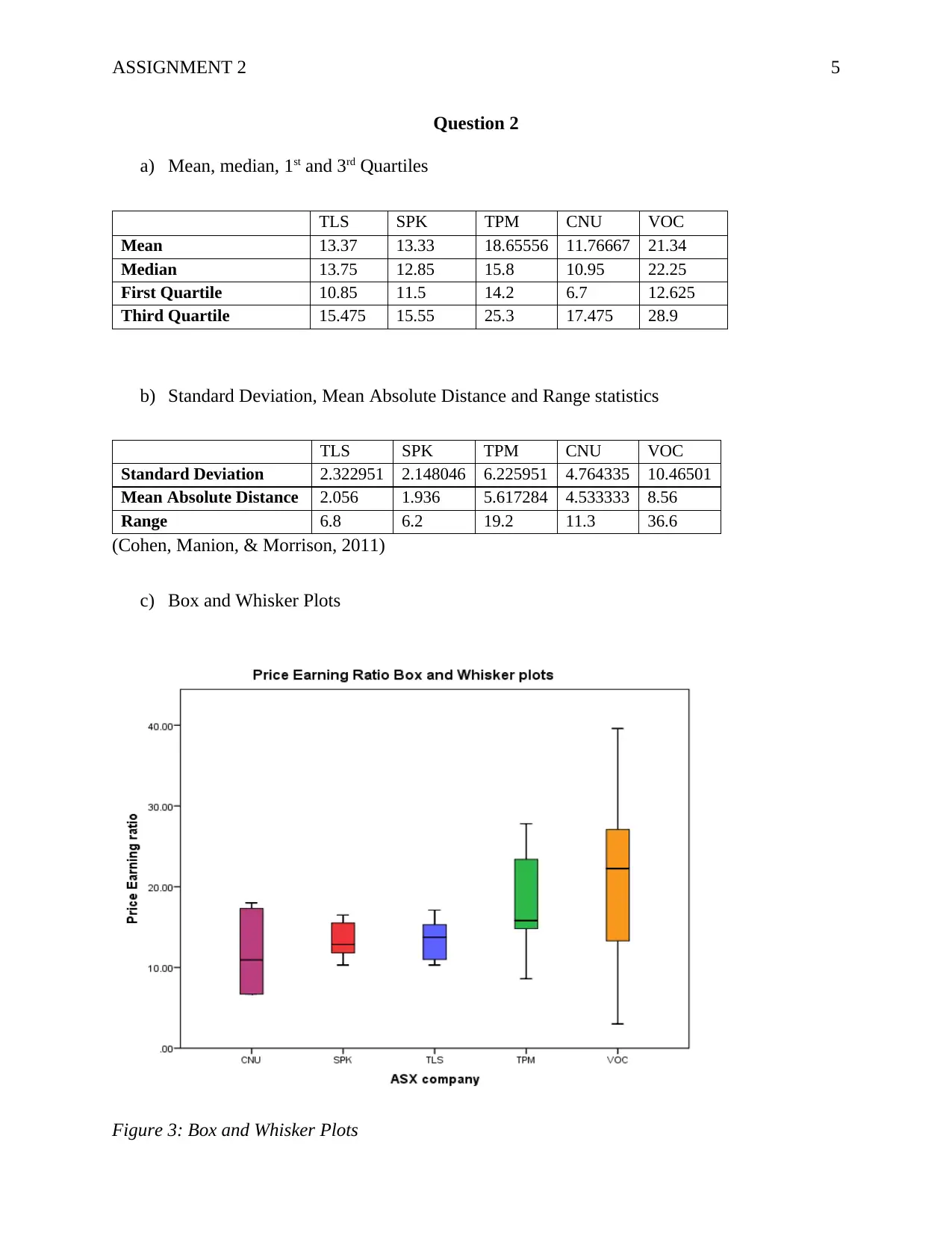
ASSIGNMENT 2 5
Question 2
a) Mean, median, 1st and 3rd Quartiles
TLS SPK TPM CNU VOC
Mean 13.37 13.33 18.65556 11.76667 21.34
Median 13.75 12.85 15.8 10.95 22.25
First Quartile 10.85 11.5 14.2 6.7 12.625
Third Quartile 15.475 15.55 25.3 17.475 28.9
b) Standard Deviation, Mean Absolute Distance and Range statistics
TLS SPK TPM CNU VOC
Standard Deviation 2.322951 2.148046 6.225951 4.764335 10.46501
Mean Absolute Distance 2.056 1.936 5.617284 4.533333 8.56
Range 6.8 6.2 19.2 11.3 36.6
(Cohen, Manion, & Morrison, 2011)
c) Box and Whisker Plots
Figure 3: Box and Whisker Plots
Question 2
a) Mean, median, 1st and 3rd Quartiles
TLS SPK TPM CNU VOC
Mean 13.37 13.33 18.65556 11.76667 21.34
Median 13.75 12.85 15.8 10.95 22.25
First Quartile 10.85 11.5 14.2 6.7 12.625
Third Quartile 15.475 15.55 25.3 17.475 28.9
b) Standard Deviation, Mean Absolute Distance and Range statistics
TLS SPK TPM CNU VOC
Standard Deviation 2.322951 2.148046 6.225951 4.764335 10.46501
Mean Absolute Distance 2.056 1.936 5.617284 4.533333 8.56
Range 6.8 6.2 19.2 11.3 36.6
(Cohen, Manion, & Morrison, 2011)
c) Box and Whisker Plots
Figure 3: Box and Whisker Plots
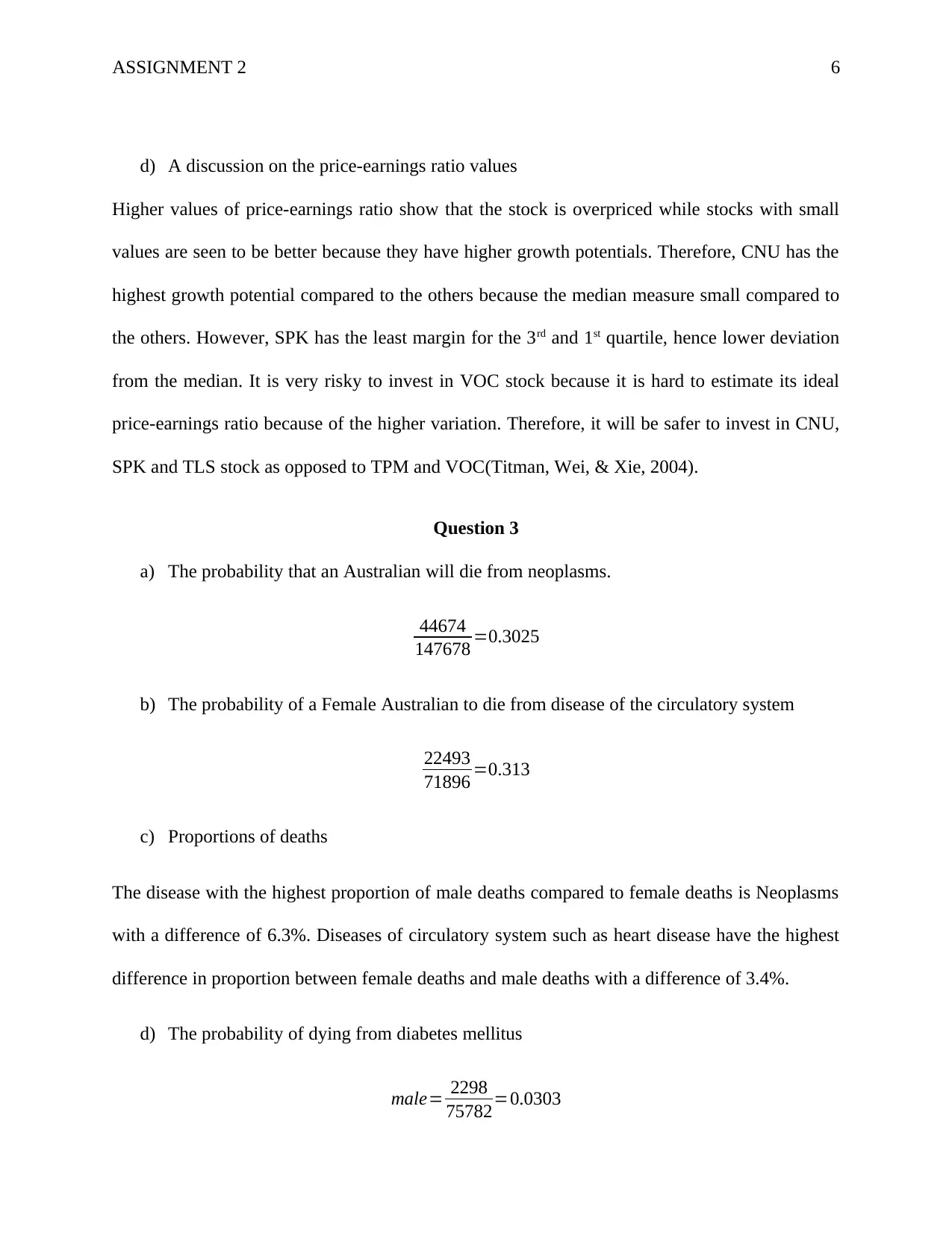
ASSIGNMENT 2 6
d) A discussion on the price-earnings ratio values
Higher values of price-earnings ratio show that the stock is overpriced while stocks with small
values are seen to be better because they have higher growth potentials. Therefore, CNU has the
highest growth potential compared to the others because the median measure small compared to
the others. However, SPK has the least margin for the 3rd and 1st quartile, hence lower deviation
from the median. It is very risky to invest in VOC stock because it is hard to estimate its ideal
price-earnings ratio because of the higher variation. Therefore, it will be safer to invest in CNU,
SPK and TLS stock as opposed to TPM and VOC(Titman, Wei, & Xie, 2004).
Question 3
a) The probability that an Australian will die from neoplasms.
44674
147678 =0.3025
b) The probability of a Female Australian to die from disease of the circulatory system
22493
71896 =0.313
c) Proportions of deaths
The disease with the highest proportion of male deaths compared to female deaths is Neoplasms
with a difference of 6.3%. Diseases of circulatory system such as heart disease have the highest
difference in proportion between female deaths and male deaths with a difference of 3.4%.
d) The probability of dying from diabetes mellitus
male= 2298
75782=0.0303
d) A discussion on the price-earnings ratio values
Higher values of price-earnings ratio show that the stock is overpriced while stocks with small
values are seen to be better because they have higher growth potentials. Therefore, CNU has the
highest growth potential compared to the others because the median measure small compared to
the others. However, SPK has the least margin for the 3rd and 1st quartile, hence lower deviation
from the median. It is very risky to invest in VOC stock because it is hard to estimate its ideal
price-earnings ratio because of the higher variation. Therefore, it will be safer to invest in CNU,
SPK and TLS stock as opposed to TPM and VOC(Titman, Wei, & Xie, 2004).
Question 3
a) The probability that an Australian will die from neoplasms.
44674
147678 =0.3025
b) The probability of a Female Australian to die from disease of the circulatory system
22493
71896 =0.313
c) Proportions of deaths
The disease with the highest proportion of male deaths compared to female deaths is Neoplasms
with a difference of 6.3%. Diseases of circulatory system such as heart disease have the highest
difference in proportion between female deaths and male deaths with a difference of 3.4%.
d) The probability of dying from diabetes mellitus
male= 2298
75782=0.0303
⊘ This is a preview!⊘
Do you want full access?
Subscribe today to unlock all pages.

Trusted by 1+ million students worldwide
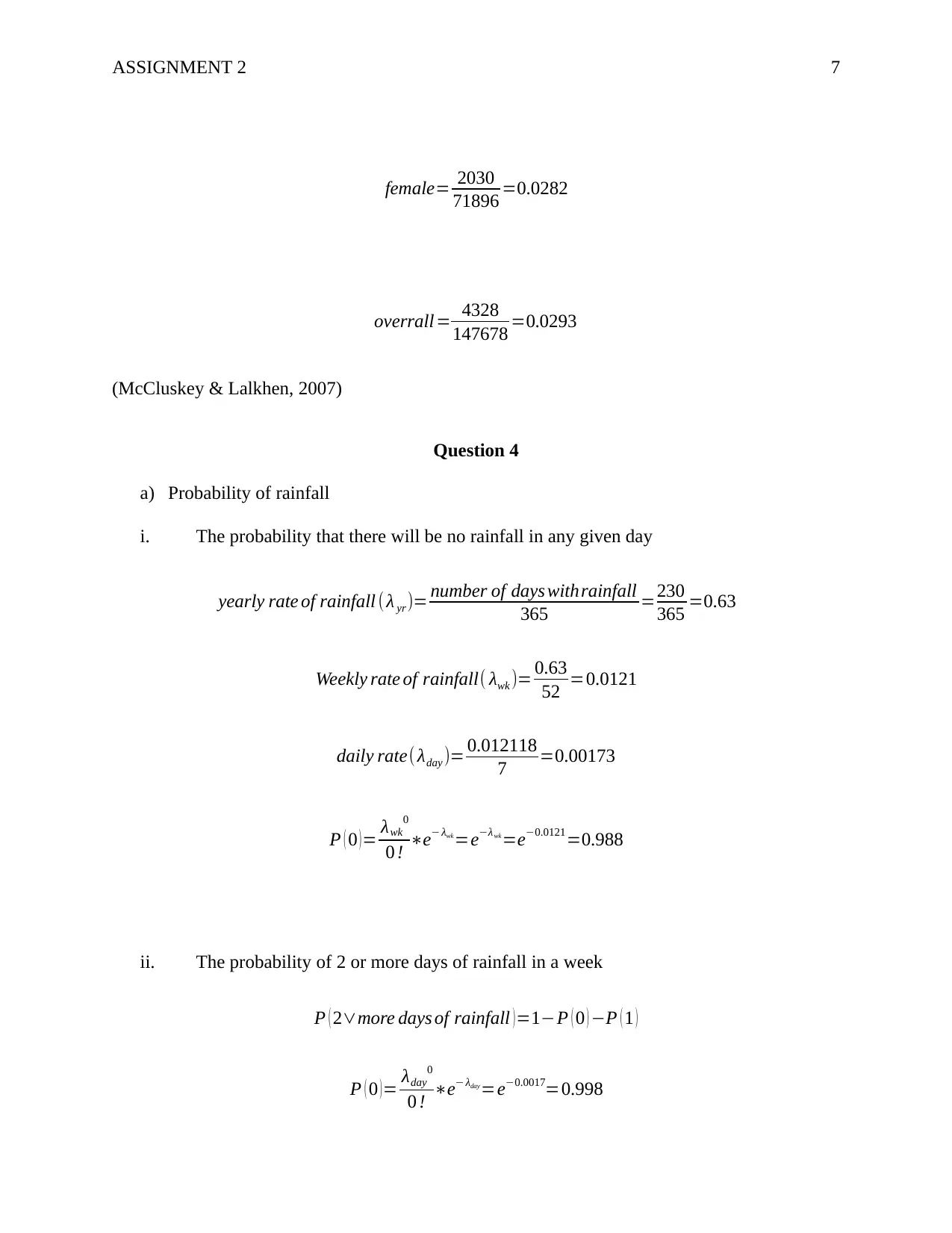
ASSIGNMENT 2 7
female= 2030
71896 =0.0282
overrall = 4328
147678 =0.0293
(McCluskey & Lalkhen, 2007)
Question 4
a) Probability of rainfall
i. The probability that there will be no rainfall in any given day
yearly rate of rainfall (λ yr)= number of days withrainfall
365 =230
365 =0.63
Weekly rate of rainfall( λwk )= 0.63
52 =0.0121
daily rate( λday )= 0.012118
7 =0.00173
P ( 0 )= λwk
0
0 ! ∗e− λwk
=e−λwk
=e−0.0121=0.988
ii. The probability of 2 or more days of rainfall in a week
P ( 2∨more days of rainfall )=1−P ( 0 ) −P ( 1 )
P ( 0 )= λday
0
0 ! ∗e− λday
=e−0.0017=0.998
female= 2030
71896 =0.0282
overrall = 4328
147678 =0.0293
(McCluskey & Lalkhen, 2007)
Question 4
a) Probability of rainfall
i. The probability that there will be no rainfall in any given day
yearly rate of rainfall (λ yr)= number of days withrainfall
365 =230
365 =0.63
Weekly rate of rainfall( λwk )= 0.63
52 =0.0121
daily rate( λday )= 0.012118
7 =0.00173
P ( 0 )= λwk
0
0 ! ∗e− λwk
=e−λwk
=e−0.0121=0.988
ii. The probability of 2 or more days of rainfall in a week
P ( 2∨more days of rainfall )=1−P ( 0 ) −P ( 1 )
P ( 0 )= λday
0
0 ! ∗e− λday
=e−0.0017=0.998
Paraphrase This Document
Need a fresh take? Get an instant paraphrase of this document with our AI Paraphraser
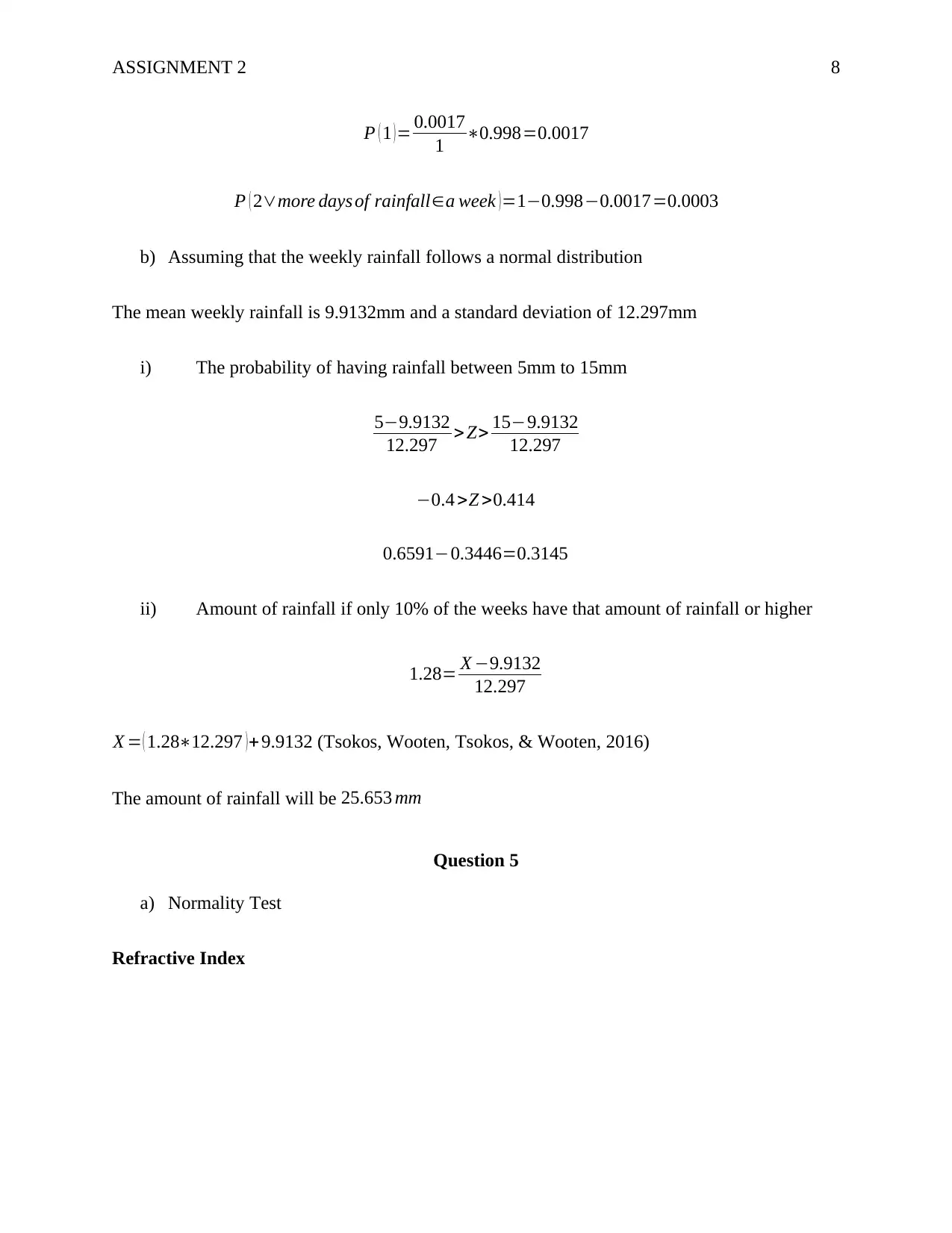
ASSIGNMENT 2 8
P ( 1 )= 0.0017
1 ∗0.998=0.0017
P ( 2∨more days of rainfall∈a week ) =1−0.998−0.0017=0.0003
b) Assuming that the weekly rainfall follows a normal distribution
The mean weekly rainfall is 9.9132mm and a standard deviation of 12.297mm
i) The probability of having rainfall between 5mm to 15mm
5−9.9132
12.297 >Z> 15−9.9132
12.297
−0.4 >Z >0.414
0.6591−0.3446=0.3145
ii) Amount of rainfall if only 10% of the weeks have that amount of rainfall or higher
1.28= X −9.9132
12.297
X = ( 1.28∗12.297 ) + 9.9132 (Tsokos, Wooten, Tsokos, & Wooten, 2016)
The amount of rainfall will be 25.653 mm
Question 5
a) Normality Test
Refractive Index
P ( 1 )= 0.0017
1 ∗0.998=0.0017
P ( 2∨more days of rainfall∈a week ) =1−0.998−0.0017=0.0003
b) Assuming that the weekly rainfall follows a normal distribution
The mean weekly rainfall is 9.9132mm and a standard deviation of 12.297mm
i) The probability of having rainfall between 5mm to 15mm
5−9.9132
12.297 >Z> 15−9.9132
12.297
−0.4 >Z >0.414
0.6591−0.3446=0.3145
ii) Amount of rainfall if only 10% of the weeks have that amount of rainfall or higher
1.28= X −9.9132
12.297
X = ( 1.28∗12.297 ) + 9.9132 (Tsokos, Wooten, Tsokos, & Wooten, 2016)
The amount of rainfall will be 25.653 mm
Question 5
a) Normality Test
Refractive Index
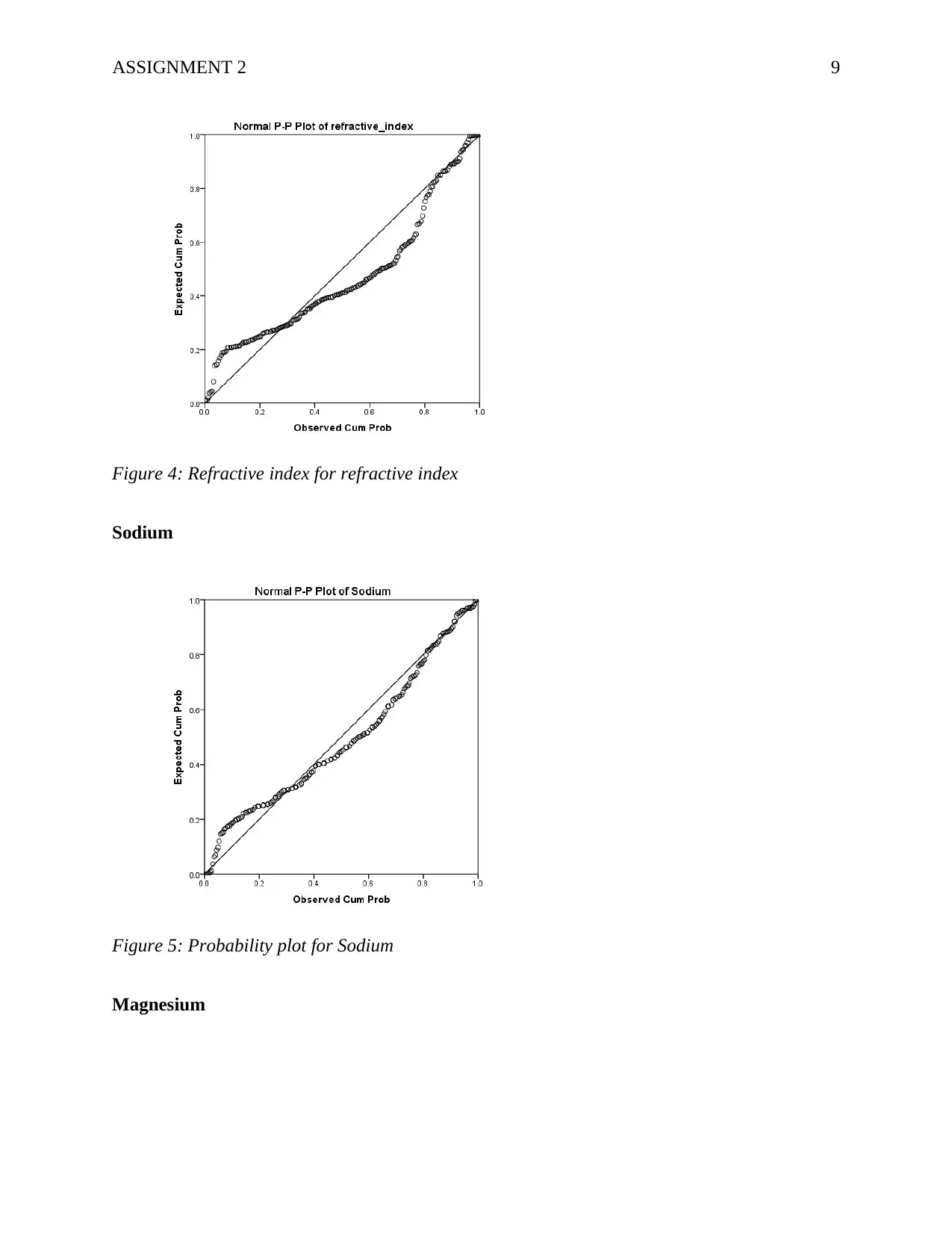
ASSIGNMENT 2 9
Figure 4: Refractive index for refractive index
Sodium
Figure 5: Probability plot for Sodium
Magnesium
Figure 4: Refractive index for refractive index
Sodium
Figure 5: Probability plot for Sodium
Magnesium
⊘ This is a preview!⊘
Do you want full access?
Subscribe today to unlock all pages.

Trusted by 1+ million students worldwide
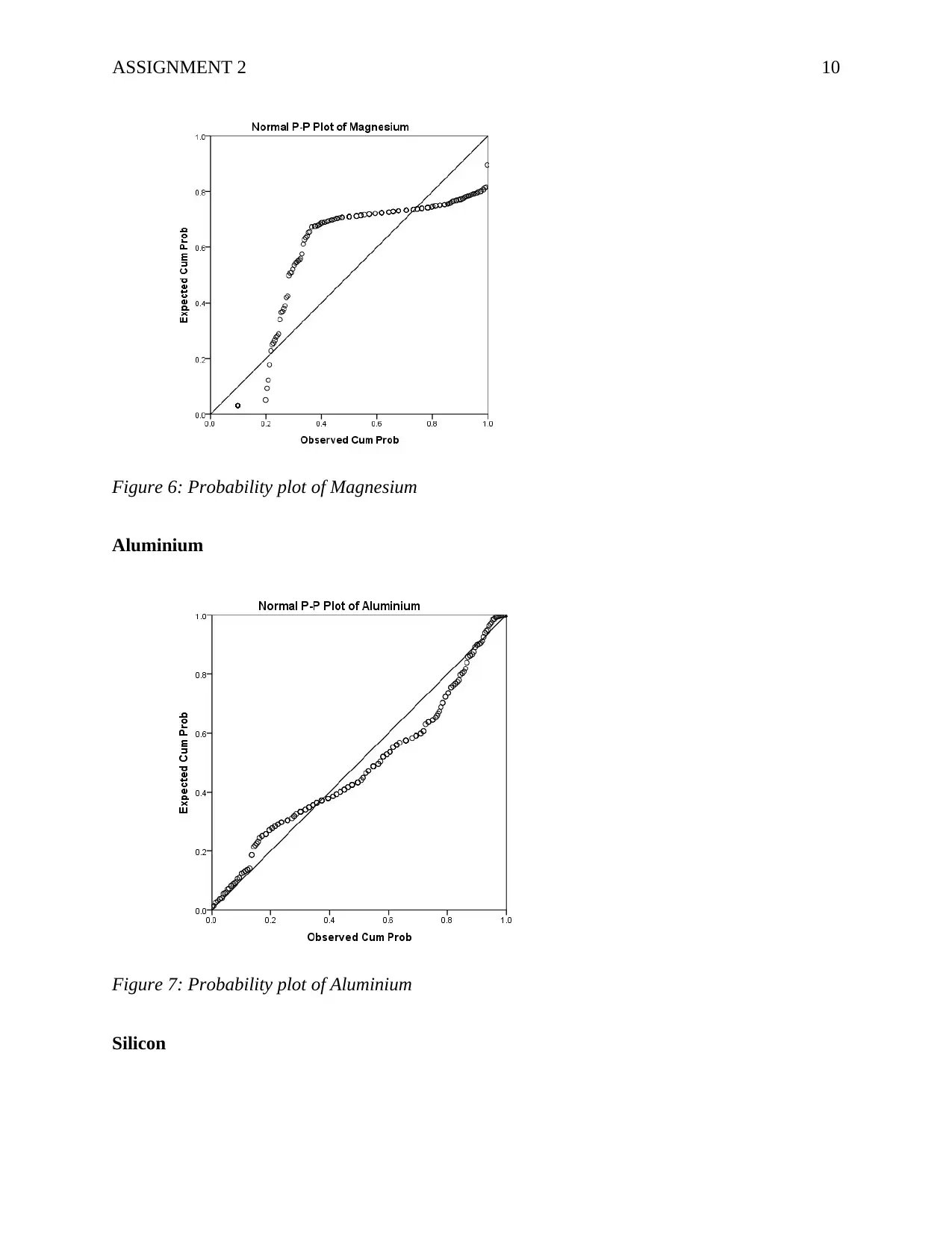
ASSIGNMENT 2 10
Figure 6: Probability plot of Magnesium
Aluminium
Figure 7: Probability plot of Aluminium
Silicon
Figure 6: Probability plot of Magnesium
Aluminium
Figure 7: Probability plot of Aluminium
Silicon
Paraphrase This Document
Need a fresh take? Get an instant paraphrase of this document with our AI Paraphraser
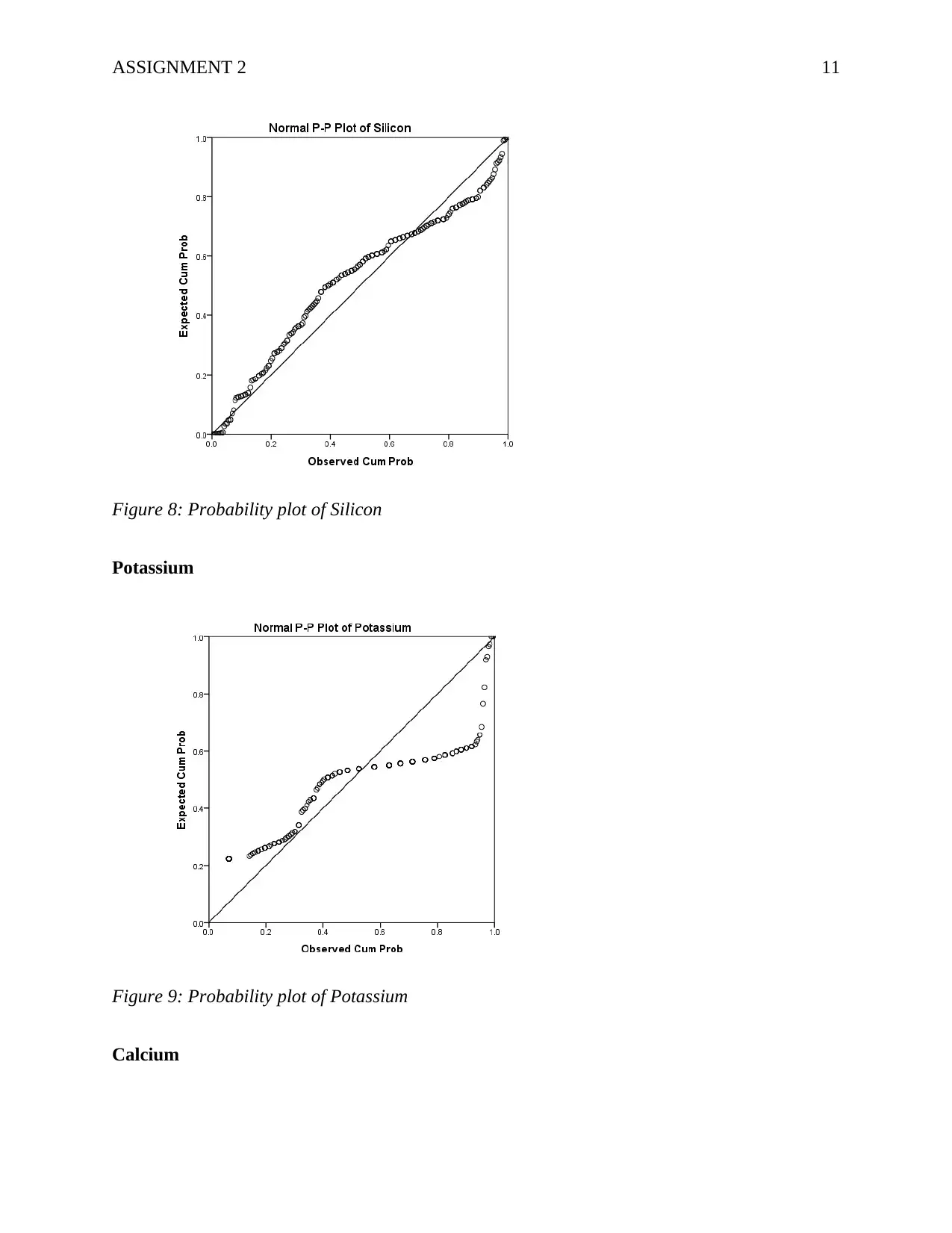
ASSIGNMENT 2 11
Figure 8: Probability plot of Silicon
Potassium
Figure 9: Probability plot of Potassium
Calcium
Figure 8: Probability plot of Silicon
Potassium
Figure 9: Probability plot of Potassium
Calcium
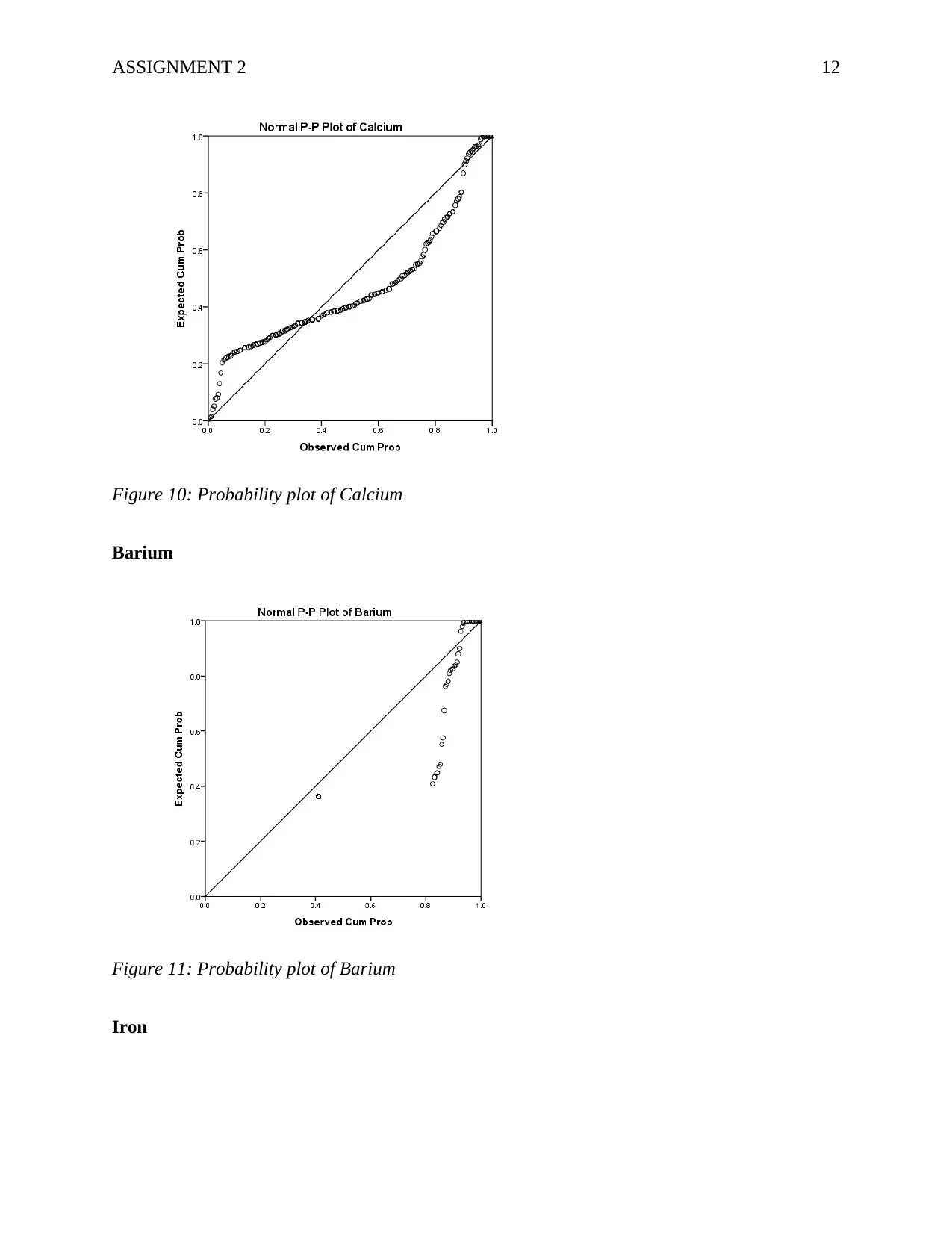
ASSIGNMENT 2 12
Figure 10: Probability plot of Calcium
Barium
Figure 11: Probability plot of Barium
Iron
Figure 10: Probability plot of Calcium
Barium
Figure 11: Probability plot of Barium
Iron
⊘ This is a preview!⊘
Do you want full access?
Subscribe today to unlock all pages.

Trusted by 1+ million students worldwide
1 out of 15
Related Documents
Your All-in-One AI-Powered Toolkit for Academic Success.
+13062052269
info@desklib.com
Available 24*7 on WhatsApp / Email
![[object Object]](/_next/static/media/star-bottom.7253800d.svg)
Unlock your academic potential
Copyright © 2020–2025 A2Z Services. All Rights Reserved. Developed and managed by ZUCOL.
![Statistics for Managerial Decision Assignment - II, [Date], Analysis](/_next/image/?url=https%3A%2F%2Fdesklib.com%2Fmedia%2Fimages%2Fdg%2F212559e8bb9e4b7a88ae50f7f34bd535.jpg&w=256&q=75)



